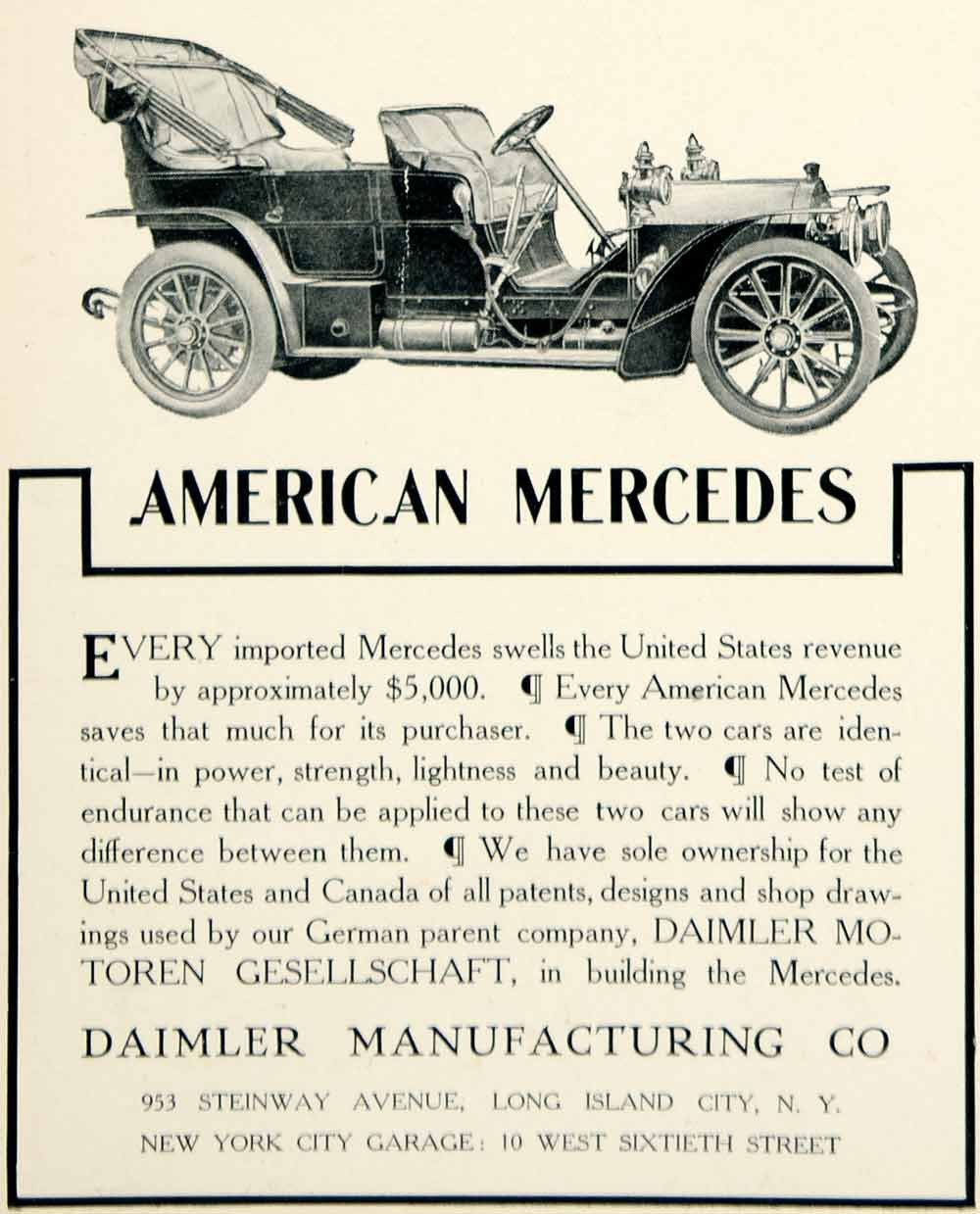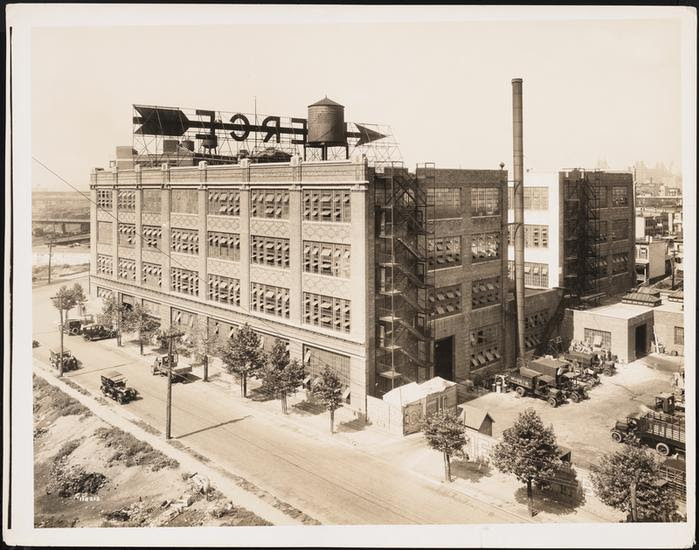MONDAY, AUGUST 3, 2020 CAR FACTORIES IN LONG ISLAND CITY


Monday, August 3rd, 2020
Our 120th Edition
MORE TREATS FROM THE PAST
THEY BUILT THE BEST CARS IN
LONG ISLAND CITY

The American Mercedes was made by Daimler Manufacturing Company of Long Island City, New York, USA from 1904 to 1907. They were licensed copies of German Mercedes models. Some commercial vehicles, such as ambulances, were also made. The company was in direct competition with Mercedes Import Co. of New York, which handled the imported Mercedes for the entirety of the United States, at least in 1906.

Manufactured on Steinway Avenue


The Brewster Building is a 400,000-square-foot (37,000 m2) building at 27-01 Queens Plaza North in Long Island City, Queens, New York City. Once an assembly plant for Rolls Royce cars and Brewster cars and Brewster Buffalo airplanes, it is now the corporate headquarters for JetBlue.
The building, designed by Stephenson & Wheeler opened in 1911 to handle the assembly of the chassis for the Brewster cars that were being built since 1905 at 47th Street and Broadway in Times Square in nearby Manhattan.
The building was one of the first major developments at the foot of the Queensboro Bridge, opened in 1909, which reduced car transport from Queens to Times Square to a matter of minutes. In 1915 it began building the Brewster Knight.
In 1925, the company was bought by Rolls-Royce of America, which had been operating out of a plant in Springfield, Massachusetts. In 1931, the Rolls Royce Springfield operation ended. From 1931 to 1934, Rolls-Royce Phantom II chassis were shipped directly to the Long Island City plant when Rolls Royce terminated its United States assembly program. From 1934 to 1936, under J. S. Inskip, Brewster automobiles using Ford chassis were built at the plant.
The Brewster operation ceased in 1936. The Brewster Aeronautical Corporation manufactured the Brewster F2A Buffalo and a version of the Vought F4U Corsair known as the F3A-1 during World War II at the plant. The multi-story layout of the building limited airplane production efficiency. The aircraft were flown from Roosevelt Field in Mineola.
PLANES WERE BUILT AT QUEENS PLAZA
The Brewster F2A Buffalo[1] is an American fighter aircraft which saw service early in World War II. Designed and built by the Brewster Aeronautical Corporation, it was one of the first U.S. monoplanes with an arrestor hook and other modifications for aircraft carriers.
PIERCE ARROW BUILDING
34 01 38 AVENUE
LONG ISLAND CITY
Pierce-Arrow. The company, based in Buffalo from 1903 to 1938, evolved from a luxury birdcage manufacturer established in 1865, Heinz, Pierce and Munschauer. Henry N. Pierce bought out his two partners and began building and retailing bicycles and motorcycles in 1896, with the leap to automobiles in 1901.
The company’s first success, a two-cylinder auto, named the Arrow, appeared in 1903. The company’s first commercial success, the four-cylinder Great Arrow, arrived in 1904. Though George Pierce sold all his company rights in 1907 and passed away in 1910, the company was known as Pierce-Arrow from 1908 to 1938
Pierce-Arrow Society, dedicated to the preservation of Pierce-Arrow Motor Cars and trucks Pierce-Arrow became known for its luxury autos, as film stars and heads of state made sure to have at least one Pierce in their collection (William H. Taft made the Arrow the first official car associated with the White House). Later, however, since Pierce-Arrow didn’t have a moderate-priced line the company suffered during the Depression and closed its Buffalo factory, which has since been declared a landmark, in 1938.

PHOTO WURTS BROTHERS (C)
MUSEUM OF THE CTIY OF NEW YORK, 1921
THE FORD BUILDING
THE CENTER BUILDING
33-00 NORTHERN BLVD.


The Ford Building in LIC’s “Carridor” Architecture
MITCH WAXMAN
To begin with, the only people who would commonly refer to this enormous example of early 20th century industrial architecture as “Ford” are Kevin Walsh and myself (and possibly Montrose).
Modernity knows it simply as “The Center Building” and it’s found at 33-00 Northern Boulevard at the corner of Honeywell Street (Honeywell is actually a truss bridge over the Sunnyside Yard, just like Thomson Avenue, but that’s another story).
This was once the Ford Assembly and Service Center of Long Island City, which shipped the “Universal Car” to all parts of the eastern United States and for cross Atlantic trade. The recent sale of the building in December 2014, for some $84.5 million, was discussed by Q’Stoner back in 2013.
The term Carridor is one that’s entirely of my own invention. A couple of blocks northeast is the Pierce Arrow Building, and about six blocks from here the Standard Motor Products Building cannot help being noticed. In the early 20th century, this part of Queens was commonly referred to as “Detroit East” for all the automobile companies which manufactured and serviced vehicles here.
The structures built along Northern Boulevard, in particular, were gargantuan. That’s not because of the street, it’s because they backed up on the Sunnyside Yard. The original 1912 section of the building is at Honeywell, and you can see the seam it shares with the 1913-14 expansion by counting three window banks in from the corner.
The Center Building is a multi-tenant combination use office property with ground floor retail and light industrial located on busy Northern Boulevard in Long Island City, borough of Queens, New York City. Located directly on the M&R subway lines and minutes to Midtown Manhattan, the eight-story office building consists of approximately 444,606 rentable square feet situated on 1.44 acre-site.
The Ford Service Center and Assembly Plant, original section, was designed by architect Albert Kahn. Kahn enjoyed a long collaboration with Henry Ford, and designed more than 1,000 commissions for the industrialist. The addition, which continued the motif and overall treatment of the original, was by architect John Graham and expanded the plant’s capacity some 400 percent. This created 500,000 square feet of industrial space. What’s missing from the structure? The large cranes which once transported raw materials into the building from Ford’s 34 car long rail spur.
This was designed as a “fireproof factory,” with five stairwells constructed behind fireproof partitions and self closing doors. The stairs all led to an external exit, and one of the iconic features found on the addition is no mere facade – these balconies over Northern Boulevard are actually a fire tower. Don’t forget that the Triangle Shirt Waist Fire had just taken place over in Manhattan in 1911, which changed EVERYTHING in New York City, as far as industrial architecture and the fire code was concerned. For that generation, the Triangle fire loomed large, just as 9/11 does for ours.
The Ford plant was sold to Goodyear Tires by 1920, as Ford shifted his operations over to a far larger location in Newark. Goodyear sold the place to the Durant Motor Co. of New York in 1921.
STANDARD MOTOR PARTS

The Standard Motor Parts Building has been rebuilt into a contemporary office spaces with a farm on the roof.
Standard Motor Products, Inc. (NYSE: SMP) is a manufacturer and distributor of automotive parts in the automotive aftermarket industry. The company was founded in 1919 as a partnership by Elias Fife and Ralph Van Allen and incorporated by Fife in 1926. It is headquartered in Long Island City, New York, and trades on the New York Stock Exchange. Standard Motor Products, Inc. sells its products to warehouse distributors and auto parts retail chains around the world, under its own brand names such as Standard, BWD Automotive, Blue Streak Automotive, Blue Streak Wire, TechSmart, Intermotor, Factory Air, and Four Seasons, as well as under private labels for key customers.
MONDAY PHOTO OF THE DAY
IDENTIFY THIS
SEND ENTRY TO ROOSEVELTISLANDHISTORY@GMAIL.COM
WIN A KIOSK TRINKET

FRIDAY PHOTO OF THE DAY

TRAM HANGERS ON TOWER
JOAN BROOKS IS THE WINNER.
EDITORIAL
We sometimes forget the enormous industrial history or Long Island City. Every few months I visit Material for the Arts at 33-00 Northern Blvd. They are located in the former car factory. As one looks out the window you can see where there were railroad sidings to load and unload the delivers to the factories located on the buildings along Northern Blvd. and facing the tracks.

NEW FEATURE
FROM OUR KIOSK
GREAT STUFF FOR ALL OCCASIONS



RI BRIDGE MAGNET AND MAIN ST. MAGNET $5- EACH
SUBWAY MAP MUG $12-
FACE MASKS $25-
KIOSK IS OPEN WEEKENDS 12 NOON TO 5 P.M.
ORDER ONLINE BY CREDIT CARD ROOSEVELTISLANDHISTORY@GMAIL.COM
Text by Judith Berdy Thanks to Bobbie Slonevsky
for her dedication to Blackwell’s Almanac
Thanks to Deborah Dorff for maintaining our website
Edited by Melanie Colter and Deborah Dorff
All materials in this publication are copyrighted (c)
ARTICLES AND PHOTOS ARE FROM
WIKIPEDIA
NEWTOWN PENTICLE
FORGOTTEN NEW YORK
MUSEUM OF THE CITY OF NEW YORK (C)
MATERIAL COPYRIGHT WIKIPEDIA, GOOGLE IMAGES, RIHS ARCHIVES AND MAY NOT BE REPRODUCED WITHOUT PERMISSION (C)
FUNDING BY ROOSEVELT ISLAND OPERATING CORPORATION PUBLIC PURPOSE FUNDING
DISCRETIONARY FUNDING BY COUNCIL MEMBER BEN KALLOS THRU NYC DYCD


Copyright © 2020 Roosevelt Island Historical Society, All rights reserved.
Our mailing address is:
rooseveltislandhistory@gmail.com

Leave a comment